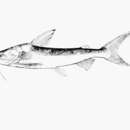Diagnostic Description
provided by Fishbase
Diagnosis: body elongated and rounded; head broad and only slightly flattened above; snout rounded; mouth inferior; maxillary barbels reaching to pectoral fin bases, mandibular ones being shorter; osseous head shield fairly visible through the skin, coarsely rugose; occipital process rather narrow at base, tapering towards its distal end, with a median keel; predorsal plate short, very rugose and crescent-shaped; premaxillary teeth villiform, forming a plate slightly curved (Ref. 57224). Palatine teeth usually in a single pair of small rounded patches, widely separated, when present, by a space much greater than their diameter (Ref. 57224, 81640). Sometimes 1 or both patches absent; usually no, infrequently 1-2 tiny, gill-rakers on posterior face of 1st and 2nd branchial arch (Ref. 57224). Total number of anterior gill-rakers on first arch: 13-15 (Ref. 57224, 81640). 14-17 gill rakers on the outer side of the entire 2nd arch (Ref. 81640). Dorsal fin short with a long, osseous, more or less serrated spine preceded by a very short one; dorsal and pectoral fins with a strong serrated, erectile spine; adipose fin well developed; caudal fin forked, with long and pointed lobes (Ref. 57224).Coloration: olive-brown above, silvered on sides, belly white (Ref. 57224).
Morphology
provided by Fishbase
Dorsal spines (total): 2; Dorsal soft rays (total): 7; Anal spines: 0; Analsoft rays: 12 - 14
Trophic Strategy
provided by Fishbase
Feeds on fish and benthic invertebrates (Ref. 28587).
Biology
provided by Fishbase
Enters brackish waters; found along the shallow continental shelf (Ref. 3876). Feeds on benthic invertebrates buried in the mud but it can sometimes leave the bottom to capture prey in open water. The females bear large eggs which are incubated and develop in the buccal cavity of the males. The rays of the fins are venomous and the wound inflicted is extremely painful (Ref. 5377). Minimum depth from Ref. 58018.

